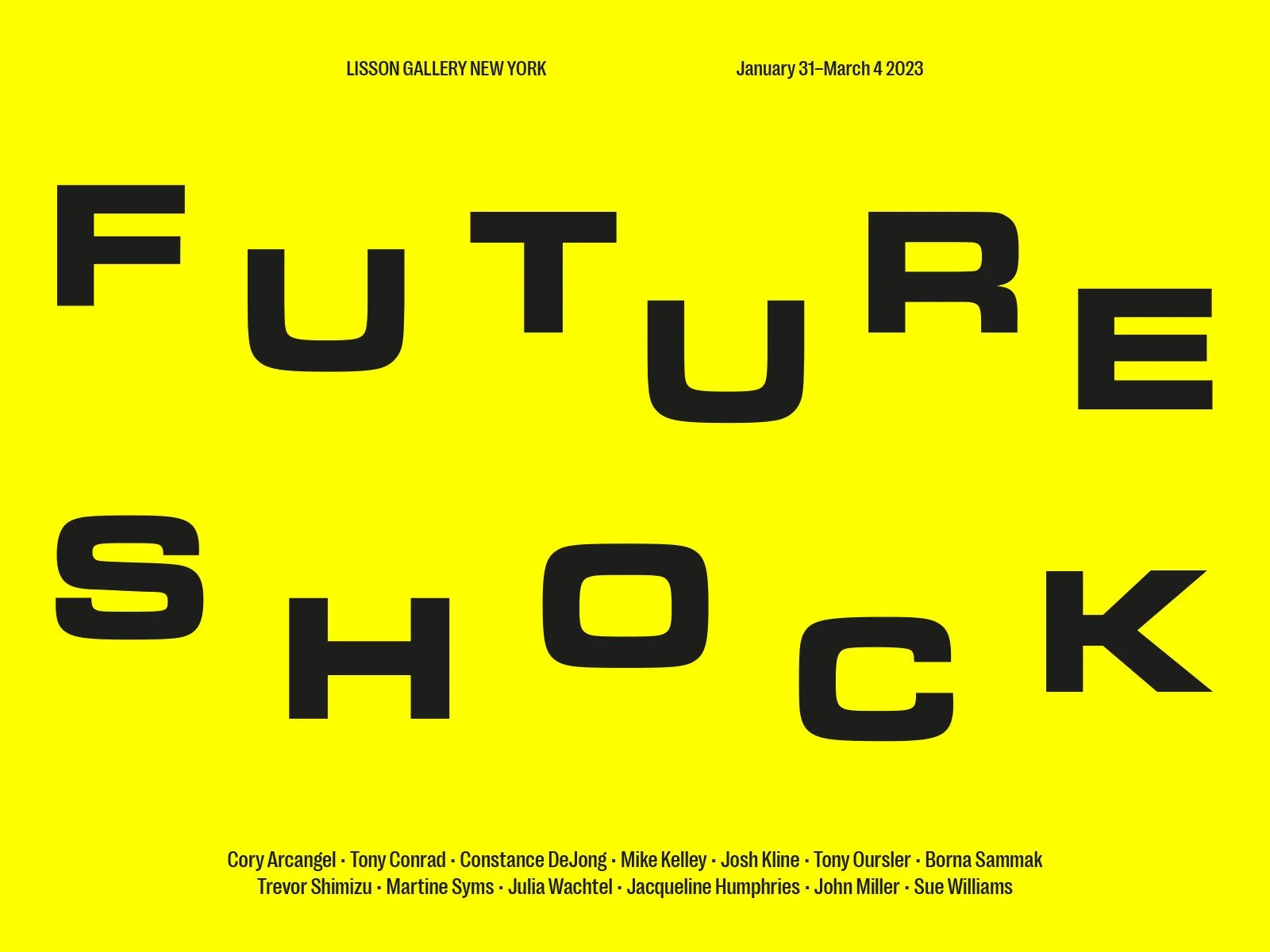FUTURE SHOCK
LISSON GALLERY
January 31 - March 4
“I coined the term ‘future shock’ to describe the shattering stress and disorientation that we induce in individuals by subjecting them to too much change in too short a time.”
- Alvin Toffler
Featuring artists Cory Arcangel, Tony Conrad, Constance DeJong, Jacqueline Humphries, Mike Kelley, Josh Kline, John Miller, Tony Oursler, Borna Sammak, Trevor Shimizu, Martine Syms, Julia Wachtel, Sue Williams
Lisson Gallery is pleased to present Future Shock, a group exhibition of artists emerging from the 1970s interconnected among their influences and collaborators as well as the next generation of artists working in video, painting and sculpture. The presentation expands across both of the gallery’s New York spaces featuring fruitful collaborations, key early works, and recent, pertinent compositions by the participating artists.
Future Shock takes its eponymous name from the prescient 1970 book by Alvin Toffler and Adelaide Farrell. The novel details the ways in which all aspects of society continue to rapidly change due to technological advancements, and exhorts the resultant psychological state of individuals and entire societies. The presentation offers a range of enquiries into the use of contemporary materials and approaches to address how technology is shaping our way of life.
The exhibition is framed by the strong ties between media art trailblazer Tony Oursler and his peers; Tony Conrad, Constance DeJong, Mike Kelley, John Miller, and Sue Williams. Considering Conrad’s treatment of structural film as both performance and sculpture in the 1960’s, as well as the responsive use of technology in performances, and Oursler’s dynamic use of projections to explore psychological dilemmas, the vanguard generation has offered the foundation for a new wave of artists adapting emergent technologies. Cory Arcangel, Josh Kline, Borna Sammak, Trevor Shimizu and Martine Syms are among the faction who continue to harness the power of contemporary technology and materials such as television, film, internet or multimedia to create sculptures, installations, paintings and videos that offer social commentary on modern culture.
Tony Oursler’s multimedia works combine sculptural elements with layers of video montage and sound, creating immersive installations with hypnotic effects. A new work from Oursler, Lux-JR (2023), probes the potential findings related to our current communities from excavations by future civilizations. One of Oursler’s earliest and most enduring collaborations is with Mike Kelley, whose works such as City 4 (2010) feature prominently in the exhibition. The two artists met while studying at CalArts in the mid-70s during its heyday of Conceptual Art, Performance, and Feminist Art which can be seen in the works of fellow CalArts students Sue Williams and John Miller, further elucidating the critical connections within the selection of artists.
A large installation of Tony Conrad’s acclaimed work, WiP (2013), stands towards the back of the 508 gallery. Originally filmed starring Tony Oursler and Mike Kelley in 1982-1983, the work directs attention to power dynamics within film by concentrating on an obfuscated genre - Women in Prison. WiP extended Conrad's examination of authority and transparency, and the recreated multimedia jail cell pushed his practice as a painter, sculptor, videographer, performer, musician, composer, and writer. Footage of Constance DeJong and Tony Oursler’s collaborative performance, Relatives (1988), fuses text and television, relating fictional family members to films, television shows and video games, along with DeJong’s more recent re-engineered radio sculpture Zenith Racetrack (2019).
Martine Syms’ timely video, My Only Idol is Reality (2007), uses an excerpt of season one of MTV’s The Real World. The episode, which aired in 1992, featured an argument about racism and privilege after the Rodney King trial. The work utilizes repetition as a structure to become more abstract – playing the video between tape decks again and again until the picture starts to disintegrate, as well as the discussion. Also focusing on a defining cultural moment from the 1990s, Trevor Shimizu’s video painting pairs footage of a personal encounter with the Tibetan Freedom Concert, with abstract painting to question common male artistic identities.
Also harnessing familiar televised events are multimedia works by Cory Arcangel that consider the growing ubiquity of technology in our homes and personal lives. The sideways-mounted screen, Super Bowl / Lakes (2017) becomes a monument to popular culture, in this case Super Bowl branding, on which Arcangel has utilized the Java program "lake” whose added code produces a wavy, liquid-like reflection on a horizontal plane reminiscent of websites in the 1990’s. Additionally, Arcangel’s use of recognizable imagery to consider the underlying implications of technology is on view in Express Yourself Clearly (2012) where JPEG sequences of Bill Clinton jogging have been uploaded into Walmart Polar Bear TVs that were marketed to families with children to increase the number of televisions within a single household.
Bringing mechanized qualities to gestural painting, Jacqueline Humphries’ Alpha (2014) evokes the static of omnipresent screens. Iconography from pop culture continues to be probed in paintings by Borna Sammak and Julia Wachtel. Extracting motifs from film, television, clothing and digital advertising, the artists explore the impact these recognizable, and repeated, symbols have on the human psyche.
With an overtly dystopian view of accelerating change, A New Career (2016), a shopping cart sculpture from Josh Kline’s Unemployment series, looks to a not-so-distant future where technological automation creates mass redundancies, while Kline’s Submersion (2019) part of his Climate Change series, ventures further into a future where the climate crisis has destroyed the American way of life and miniature interiors are preserved as specimens within a glowing lab hood.
